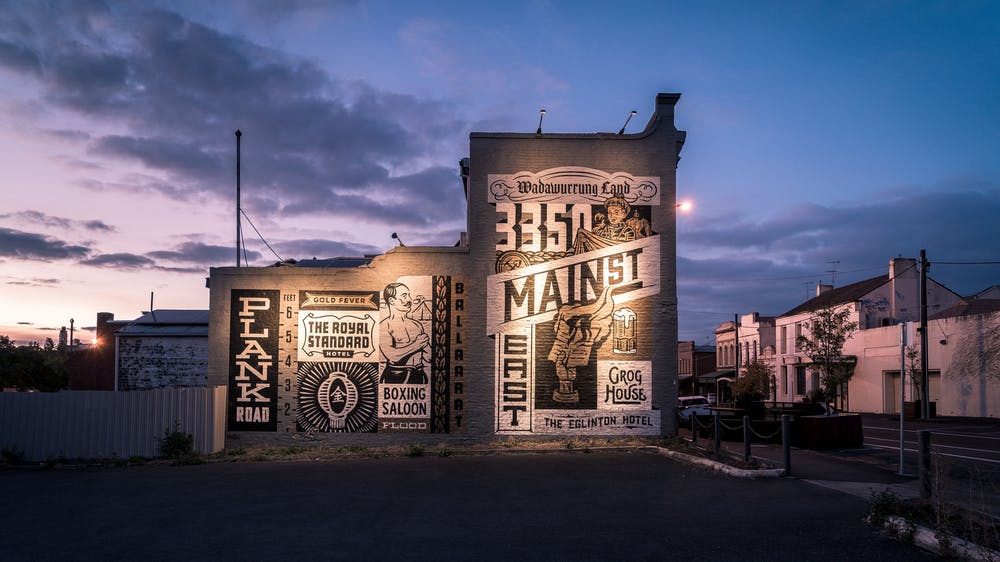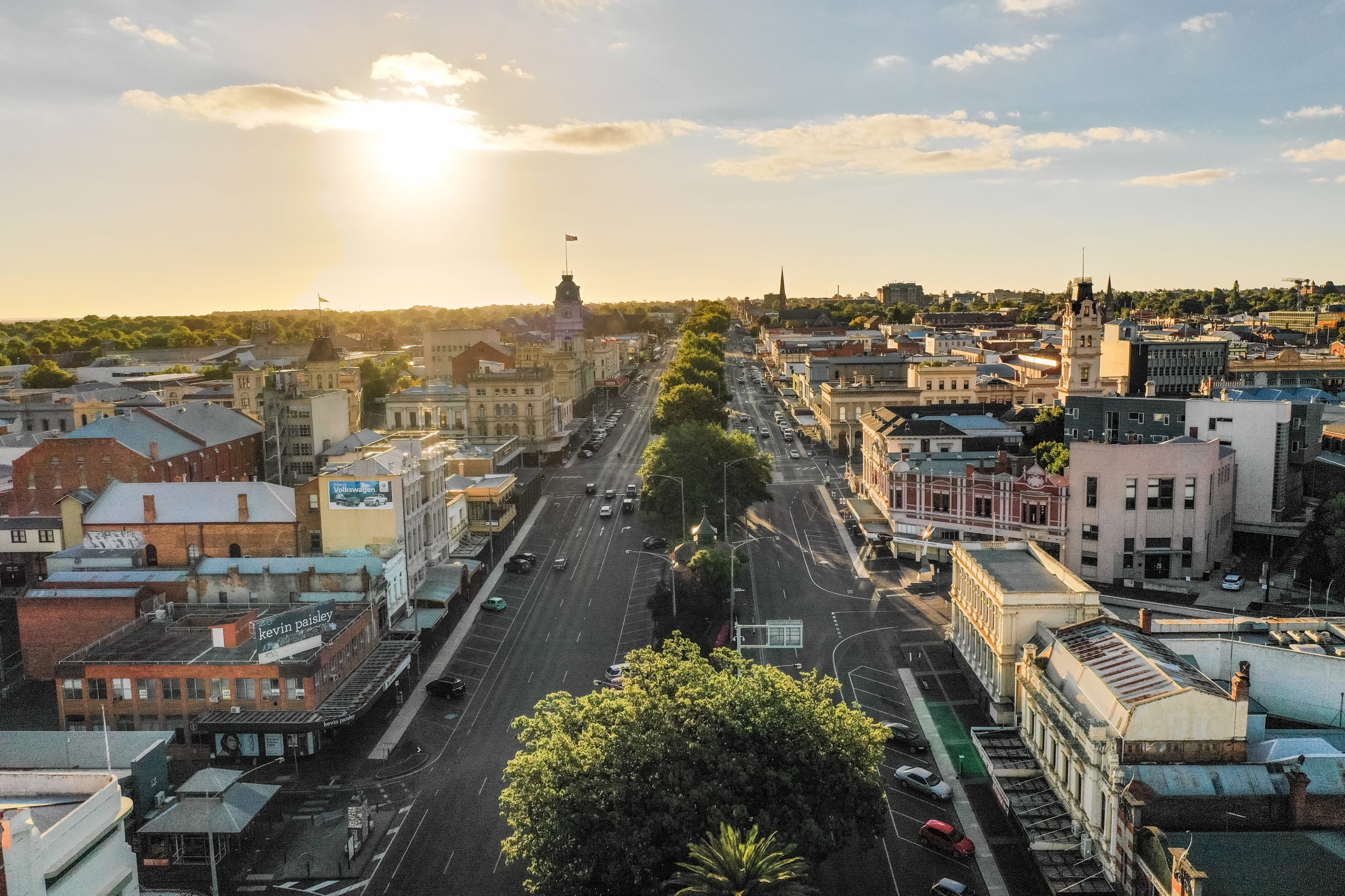Start typing to search
You can also hit “Enter” on your keyboard to submit your query.
0What's on
0Everything Else
Ballarat Public Art Walks: War History
Visit Ballarat
17 Oct 2022
Filed underSee & Do
This is one of four public art walks highlighting the City of Ballarat’s Public Art Collection.
The collection holds over 120 artworks and is one of the largest and most significant regional public art collections in Australia.
- Moderate walk, some inclines
- 1-1.5 hours
Boer War Memorial
James White (1906)
Sturt Street
The Boer War Memorial was created by sculptor James White in honour of Australian soldiers who fought in the South African War (1899-1902).
White used the electrolytic copper deposit method to produce this large statue, which is sometimes mistaken for a cast bronze work.
The foundation stone was laid on 18 May 1901 by H.R.H The Duke of York (George V).
The sculpture was unveiled on 1 November 1906 by His Excellency Baron Northcote G.C.I.E., C.B. Governor General of Australia and then Mayor of Ballarat, J. J. Brokenshire.
Bravery and mateship are beautifully captured in depiction of a scene taken straight from the battlegrounds.
Today the memorial is a much-photographed homage and is of historical and aesthetic significance to Ballarat.
William Dunstan VC Memorial
Sturt Street (1995)
The Dunstan Memorial is a minimal form of rough-cut bluestone and sheet granite in memory of Ballarat-born soldier, William Dunstan, who served with honour in Gallipoli.
His unit successfully defended a post despite being seriously wounded.
He and one mate were the only survivors of the 10 men defending the trench and all were awarded the Victoria Cross.
Following the war, Dunstan worked as manager and director of The Herald and Weekly Times.
Harold Pompey Elliott
Louis Laumen (2011)
Sturt Street
Harold Edward ‘Pompey’ Elliot was first and foremost a soldier.
Schooled in Ballarat, he spoke often of his love of battle, and the sheer beauty of the fighting troops.
This contemporary bronze sculpture has detailed elements of the uniform and posture of the military of the time and stance of a man sure of his own strength and willing to command in the harshest of conditions.
Signed by the artist along the sword scabbard.
Stamp of foundry marking on the boot edging.
The four plaques surround the sculpture and plinth detail part of the story of the Major-General and Senator.
Albert Coates
Louis Laumen (2012)
Sturt Street
Leading surgeon and academic Sir Albert Coates was one of Ballarat’s most celebrated sons.
A medical orderly during WWI, he returned home to become a pioneering neurosurgeon.
A medical man in the worst of circumstances, Coates is often mentioned for his compassion and care in his role as a doctor in the Burma-Siam Railway POW camps.
The bronze statue by Louis Lauman captures his down-to-earth nature.
Laumen is a Melbourne sculptor who has completed many commissioned bronze public artworks around Australia
Korea, Malaya, Borneo, Vietnam
Sturt Street (2000)
‘Lest We Forget’ is a contemporary and crisp treatment, marking the sacrifices of Australian forces involved in the conflicts of south-east Asia, including the Korean War (1950-53), the Malayan Emergency (1950-60), the Borneo Uprising (1962-64) and the Vietnam War (1962-72).
A plaque was added in 2006 by the Victorian Vietnam Veterans Community in commemoration of the 40th anniversary of the Battle of Long Tan.
Eternal Flame
Peter Blizzard (1995)
Sturt Street
Eternal Flame was created by renowned Ballarat sculptor Peter Blizzard as a marker of the end of WWII in the Pacific.
Engraved into the bluestone-shaped tile across the base of the statue is details about conflict areas where Australian Troops were active.
The metal structure mimics a moving flame with its polished golden hue, a feature included in many war memorials around the world.
Peter Blizzard also designed the Australian Ex-Prisoners of War Memorial in the South Gardens at the Ballarat Botanical Gardens.
WWI Cenotaph
Sturt Street (1949)
The Ballarat Cenotaph commemorates those who died in service or were killed in action in WWI and WWII.
The cenotaph was unveiled by the Governor, Sir Dallas Brooks on 24 November 1949 in front of a crowd estimated to be between 3000 and 4000 people.
It was made possible through donations bolstered by an ANZAC Day radio appeal.
George Treloar Memorial
Lis Johnson
Sturt Street
This depiction of Major George Devine Treloar by artist Lis Johnson was commissioned by the George Devine Treloar Memorial Committee, an initiative of Merimna Kynon of Oceania, Central Portian Pontion Association of Melbourne and Victoria Pontiaki Estiaâ and the City of Ballarat.
Treloar was appointed as the League of Nations Commissioner for Refugees in Greece in 1922 where he worked to provide food, aid and comfort to what would eventually total over 100,000 refugees from the collapsing Ottoman Empire.
This memorial grew from the desire of the descendants of refugees to honour his memory and his humanitarian work.

Australian Ex-Prisoners of War Memorial
Peter Blizzard (2004)
South Gardens, Lake Wendouree
This memorial to Australian Prisoners of War is dedicated to more than 36,000 Australian men and women who were held captive as prisoners by the enemy during the Boer War, World War 1, World War 2 and the Korean War. This memorial honours them.
Water springs from beneath the ‘Lest We Forget’ stone then flows down the wall into the narrow watercourse in front of the first group of names and into the reflective pool, then continues past the second group of names.
Finally it disappears under the pathway, returning to its source under the ‘Lest We Forget’ stone to start the journey again.
Water symbolizes the essential nature of man, sacrifice, suffering, spirituality, healing, cleansing, birth and re-birth.
In this memorial, it forms a continuous cycle, binding all Australian Prisoners of War together for all time.
The memorial is created from natural materials and is designed to be in harmony with the Ballarat Botanical Gardens, and to create a sense of timeless, dignity and respect.

Arch of Victory
Sturt Street/Avenue of Honour (1920)
A grand cement rendered masonry structure of a single central arch flanked by wide piers 20 metres in width, spanning the roadway, and 18 metres high.
Crowned by the ‘Rising Sun’ symbol of the Australian Commonwealth Military Forces beneath which the words Avenue of Honour and Victory are written prominently across the arch.
The Arch marks the beginning of a 22 kilometre stretch of 3728 trees, each one a memorial to men and women in order of enlistment for World War 1.
On 2 June 1920, the Prince of Wales opened the Arch and was presented with a pair of silk pyjamas embroidered with Australian emblems.
Each of the 500 ‘Lucas Girls’ had put in a stitch.

Garden of the Grieving Mother
Peter Corlett (2017)
Learmonth Street, Sturt Street
The Garden of the Grieving Mother is an acknowledgement of the trauma, grief and anxiety felt by the families of Australian servicemen and women.
Of the 3,801 WWI service men and women commemorated in the Ballarat Avenue of Honour, 1 in 5 made the ultimate sacrifice, giving their lives.
At the centre of the memorial space is a bronze sculpture of a mother clutching a photograph of her son by sculptor Peter Corlett, who has created many war memorial public artworks.
The memorial was unveiled on 15 February 2017 by Governor General Sir Peter Cosgrove and Mrs Kaye Baird, mother of posthumous Victoria Cross recipient, Corporal Cameron Baird.




